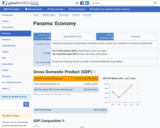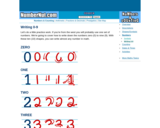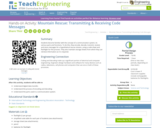
A description and economic indicators of the recent economy in Panama. It is current through 2015.
- Subject:
- Social Studies
- Material Type:
- Reading
- Provider:
- Michigan State University
- Date Added:
- 12/01/2023

A description and economic indicators of the recent economy in Panama. It is current through 2015.

This collection, which includes videos, blog articles, student handouts, lesson plans, and tip sheets for families, helps students identify, analyze, and investigate the news and information they get from online sources. Media literacy is an essential skill for all students across a range of subjects, from Science to Social Studies to English Language Arts. The collection is also useful for a behind-the-scenes look at journalism and how information is researched, shaped, and reported. Check out the resources in the collection topics.

A simple lesson giving instructions on how to write numbers from zero to nine. Writing examples provided as well as links to related counting and number identification games. Both games are interactive and easy to grasp. Activities best suited for early learners.

A resource for learning about misplaced/dangling modifiers and finding and correcting them in your writing. Complete with examples and revisions.

The 20th century was the first century that made use of data collection to track the American population. This interesting site provides a timeline of the century by significant events and measures of data.

This site contains many facts and figures about the economy of Germany.

Use this site to explore how you create communities, how you live in them, and how you change them. This site also has information on the career of city planning, and activities on city planning.

This video segment adapted from Discovering Women uses animations to introduce the theory of plate tectonics and to explain why earthquakes occur and how continents form. 2m 21s

This lesson teaches students to create an original poem based on select words and phrases from a prose piece. Also encourages students to model poetic forms after found poems.

This site provides a copy of Woodrow Wilson's speech of the Fourteen Points given during World War I.

Extensive information about William Shakespeare. Includes links to plays and productions, performance history, life and times, events and workshops, pictures and more.

Search biographical dictionary for famous people by using keywords or dates such as birth and death years, achievements, awards, literary or artistic works, or occupation and positions held. This is a Wikipedia type system where everyone can edit biographies or even create their own. L.9-10.4c References, L.11-12.4c References

An in-depth description of ladybugs, including their classification, appearance, habitat, adaptations, reproduction, diet, and other interesting facts.

Tips and information about how to evaluate resources, both print and electronic. Includes information about source authority, purpose, objectivity, currency, completeness, and relevance. It includes a printable handout (top right)with questions to ask yourself and where to look for the answers. RI.11-12.7 Eval Different Media/format

In this activity, students compare the properties and attributes of different functions.

Students become familiar with the concept of a communication system, its various parts and functions. To do this, they encode, decode, transmit, receive and store messages for a hypothetical rescue mission, using a code sheet and flashlight for this process.They also maintain storage sheets from which they can retrieve information as it is required.

Water is a limited and sometimes scarce resource. What do you do when the supply is limited?

Five lesson plans, complete with videos, primary sources, and document-based questions (DBQ) to encourage students to utilize primary sources and incorporate thinking and writing into daily learning. Topics include: Artifact & Document Analysis, Compare & Contrast, Four Corners/Jigsaw, Graphic Organizers, and PERSIA (Political, Economical, Religious, Social, Intellectual, Artistic).

This set contains questions regarding Type I and Type II errors, and the power of an inference test. Students differentiate between Type I and Type II errors, and their relationship to the null and alternative hypotheses.